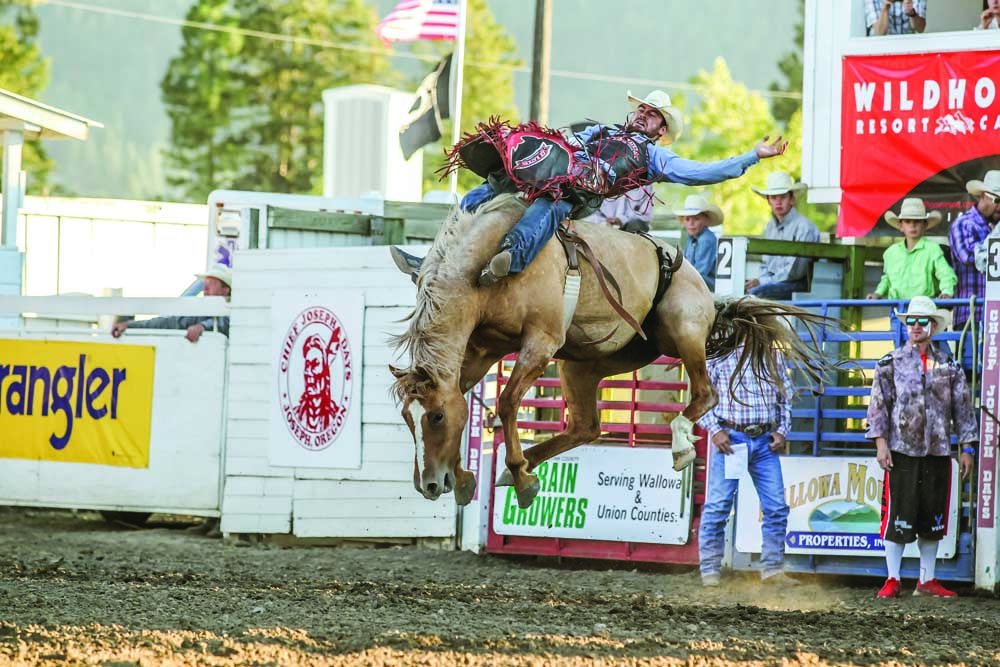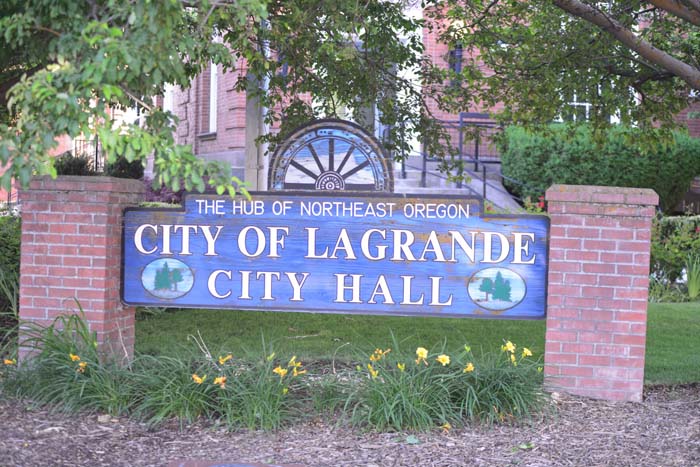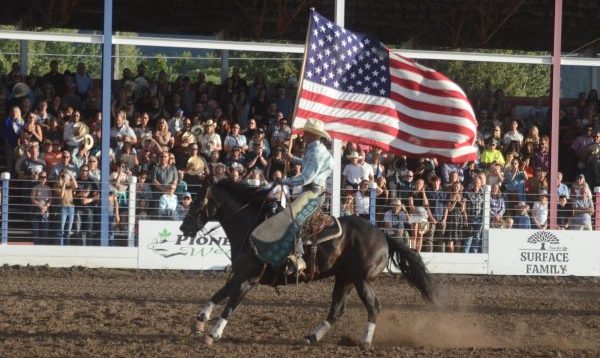CJD Shooting Horses
Published 6:00 am Wednesday, July 10, 2019

- One of Angelika Dietrich’s favorite shots from last year’s Chief Joseph Days rodeo is this photo of Logan Patterson aboard a Bridwell bareback horse.
While you are thrilling to the bulls, broncs, barrels and bull doggers at the Chief Joseph Days Rodeo, you might also notice a slim, attractive blonde woman crouched at the arena fence. She’ll be festooned with bulky professional cameras—at least two of them–and her attention will be riveted on rodeo action. That woman is Angelika Ursula Dietrich. She’s among the best and fastest shooters of horses and rodeos in the west. Her images grace the Chief Joseph Days program, website, and promotional materials. Her photographs capture what is in her heart.
Dietrich was born in southern Germany. As a girl, she rode show jumpers, learning the balance and finesse of true horsemanship. She also acquired what she describes as a “budget 35mm” camera and began taking pictures. “I was 16,” she said. “Nothing was automatic. I learned photography from scratch. When I wasn’t sitting in the saddle at horse shows, I was down on the ground taking pictures. That’s how I started out. A couple of years later I bought a Canon camera and I’ve been with Canon ever since.”
Trending
Her passion for equine photography turned to rodeo and rodeo photography in 1988 when she moved to Milton Freewater and began shooting images for the Milton-Freewater Pioneer Posse. “It was the first time I shot on a professional level. Because I had been on horseback most of my life, I could understand and feel the rhythm of the horses and the livestock. I would count along the strides of the horses and anticipate what was going to happen, even with the broncs, “she said. “I still count, all the time.”
After she moved to Wallowa County, Dietrich began looking for a way to apply her gifts for equine and rodeo photography and her skills in graphic design. In 2010 she started as Chief Joseph Days’ webmaster and PR photographer. A few years later she took over designing the Chief Joseph Days Rodeo program. It was the perfect match.
Being a rodeo photographer has its dangers and less than glamorous moments. A few years ago, Dietrich was in her usual position, crouched behind the fence, her attention focused on a fiercely bucking bronc and his perilously balanced rider. “This humongous black bronc—and I know which horse it is because he has a specific grunt–he came out of the chute like I expected, and it was one heck of a ride. I kept shooting and shooting. He came closer and closer, and I’m thinking “Is this real or is it Memorex?’”
It was real. The bronc crashed into the fence right in front of Dietrich, ejecting his rider over the seven-foot high barrier. As Dietrich frantically backed away from the wreck, the rider got up, smiled at her, and nimbly jumped back over fence into the arena. “I remember thinking “Wow-you’re kind of cute” just before I collided with the steel post behind me,” she said. Dietrich’s camera was fine, but she had chipped a bone in her shoulder. She was the only casualty of the mishap.
Today, Dietrich designs and photographs the entire Chief Joseph Days program book, accompanies and documents the travels, travails, and triumphs of the Rodeo’s court, and of course photographs the events of the entire 5 days of rodeo, from the Tuesday afternoon bucking horse stampede through cowboy church on Sunday. Every event is a special one when she’s watching it through the viewfinder.
“What I always tell other people who want to take rodeo photos is that I can’t teach you what I feel,” she said. “A little change in angle is important. Light is important. Everything I see at rodeos is slow motion. My brain just completely slows down. That’s how I get those shots. I can see the action, the positions coming. I can just feel it coming. And then, kaboom!, there it is.”
Trending
Because the Chief Joseph Days rodeo contractor, Bridwell, brings back many of the same horses each year, Dietrich has learned to recognize them. “I know how they grunt, and how they behave in the chute. I know exactly what’s coming out and that helps,” she said. “You’re going to get a great shot because you know that horse. Those horses just stay in my heart.”
Dietrich shoots mostly with a bulky but uncannily sharp and quick-focusing Canon DX1 professional camera and 70-200 f2.8 lens. Her camera, like most big, professional DSLR’s, shoots clear images in dark, low-light conditions like those encountered when the big broncs and bulls show their stuff. For closer work, when the subject is heading for the fence, she grabs her second camera with a wider angle 28-70 2.8 zoom. In rodeo, there’s no time to switch lenses. So two cameras–sometimes three–each with a different lens, are a must.
Dietrich’s advice to spectators who want to shoot rodeo is to just keep shooting. “Everybody shoots with a phone now,” she said. “Just keep on shooting and practicing. But if you want anything more close-up, you’ll have to go to a 35mm camera and a long lens. To get good pictures at Chief Joseph Days, which is mostly at night, you really need expensive, professional equipment.”
Although Dietrich can’t sell her images of Chief Joseph Days because she, by choice, is not a registered Professional Rodeo Cowboys of America (PRCA) photographer, she does cover the other rodeos in Wallowa County, including Mountain High Broncs and Bulls and the Chief Joseph Days Run-up Ranch Rodeo. You can see her work at rodeos and other events on her website: www.AngelikaDesigns.com.









